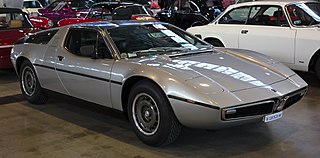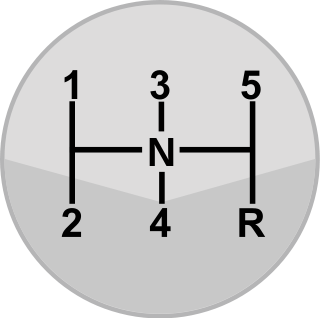Related Research Articles

The Citroën SM is a high-performance coupé produced by the French manufacturer Citroën from 1970 to 1975. The SM placed third in the 1971 European Car of the Year contest, trailing its stablemate Citroën GS, and won the 1972 Motor Trend Car of the Year award in the U.S.

The Citroën DS is a front mid-engined, front-wheel drive executive car manufactured and marketed by Citroën from 1955 to 1975, in fastback/sedan, wagon/estate, and convertible body configurations, across three series of one generation.

Cruise control is a system that automatically controls the speed of an automobile. The system is a servomechanism that takes over the throttle of the car to maintain a steady speed as set by the driver.

An automatic transmission is a multi-speed transmission used in motor vehicles that does not require any input from the driver to change forward gears under normal driving conditions. Vehicles with internal combustion engines, unlike electric vehicles, require the engine to operate in a narrow range of rates of rotation, requiring a gearbox, operated manually or automatically, to drive the wheels over a wide range of speeds.

The Citroën GS is a front-engine, front-drive, four or five door, five passenger family car manufactured and marketed by Citroën in two series: for model years 1970–1979 in fastback saloon and estate bodystyles and subsequently as the GSA for model years 1980–1989 in hatchback and estate body styles – the latter after a facelift. Combined production reached approximately 2.5 million.

The Maserati Bora is a two-seat, rear mid-engine, rear-wheel drive sports car and grand tourer, manufactured by Maserati from 1971 to 1978. In common with other Maserati cars of the era, it is named after a wind, Bora being the wind of Trieste. The Bora was the company's first mid-engined street car and ended Maserati's reputation for producing fast but technologically out of date cars, also being the first Maserati with four wheel independent suspension. In contrast, competitor Lamborghini had first used full independent suspension in 1964.

The Mitsubishi Eclipse is a sport compact car that was produced by Mitsubishi in four generations from 1989 until 2011. A convertible body style was added during the 1996 model year.

A manual transmission (MT), also known as manual gearbox, standard transmission, or stick shift, is a multi-speed motor vehicle transmission system, where gear changes require the driver to manually select the gears by operating a gear stick and clutch.

In mechanical or automotive engineering, a freewheel or overrunning clutch is a device in a transmission that disengages the driveshaft from the driven shaft when the driven shaft rotates faster than the driveshaft. An overdrive is sometimes mistakenly called a freewheel, but is otherwise unrelated.

Drive by wire or DbW technology in the automotive industry is the use of electronic or electro-mechanical systems in place of mechanical linkages that control driving functions. The concept is similar to fly-by-wire in the aviation industry. Drive-by-wire may refer to just the propulsion of the vehicle through electronic throttle control, or it may refer to electronic control over propulsion as well as steering and braking, which separately are known as steer by wire and brake by wire, along with electronic control over other vehicle driving functions.

A direct-shift gearbox is an electronically controlled, dual-clutch, multiple-shaft, automatic gearbox, in either a transaxle or traditional transmission layout, with automated clutch operation, and with fully-automatic or semi-manual gear selection. The first dual-clutch transmissions were derived from Porsche in-house development for the Porsche 962 in the 1980s.

A gear stick, gear lever, gearshift or shifter, more formally known as a transmission lever, is a metal lever attached to the transmission of an automobile. The term gear stick mostly refers to the shift lever of a manual transmission, while in an automatic transmission, a similar lever is known as a gear selector. A gear stick will normally be used to change gear whilst depressing the clutch pedal with the left foot to disengage the engine from the drivetrain and wheels. Automatic transmission vehicles, including hydraulic automatic transmissions, automated manual and older semi-automatic transmissions, like VW Autostick, and those with continuously variable transmissions, do not require a physical clutch pedal.
Clutch control refers to the act of controlling the speed of a vehicle with a manual transmission by partially engaging the clutch plate, using the clutch pedal instead of the accelerator pedal. The purpose of a clutch is in part to allow such control; in particular, a clutch provides transfer of torque between shafts spinning at different speeds. In the extreme, clutch control is used in performance driving, such as starting from a dead stop with the engine producing maximum torque at high RPM.

The Rover 6 was a small two-seater 6-horsepower car and only the second car model made by the British Rover car company. Announced in January 1905 a 6-horsepower car remained available from Rover until 1912.

The Austin 10 hp is a high-quality small car produced between 1910 and 1915 by the British car manufacturer Austin Motor Company Limited at their Longbridge, Worcestershire plant near Birmingham. 1,336 cars were made, 213 with the 1125 cc engine and 1,123 with the 1615 cc engine. Like the 1087 cc Austin 7 hp produced by both Austin and Du Cros's Swift Motor Company it was not very successful when sold with the small engine.

A motorcycle transmission is a transmission created specifically for motorcycle applications. They may also be found in use on other light vehicles such as motor tricycles and quadbikes, go-karts, offroad buggies, auto rickshaws, mowers, and other utility vehicles, microcars, and even some superlight racing cars.
The Austin 15-20 is the smaller-engined of the almost identical pair of new cars announced by Herbert Austin in February 1906. A very complete catalogue with detailed specifications was issued at the same time. As well as the engine's smaller bore the 15-20 differed from the 25-30 by being only available with a live rear axle and not chain-drive. Otherwise the specifications were the same, the very minor differences are detailed below.

Car controls are the components in automobiles and other powered road vehicles, such as trucks and buses, used for driving and parking.
The Equus Bass 770 is a handcrafted American luxury muscle car manufactured by the company Equus Automotive, named after its founder Bassam Abdallah.
References
- 1 2 3 4 5 Maricle, Rachael. "Helicron- 1932 - Lane Motor Museum". www.lanemotormuseum.org. Retrieved 2017-04-30.
- ↑ "1932 Helicron No. 1 - conceptcarz.com". conceptcarz.com. Retrieved 2017-04-30.
- ↑ Jalopnik (2016-09-15), What It's Like To Drive A Car That Can Mulch Pedestrians , retrieved 2017-04-30